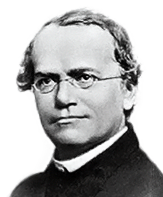Look at those glasses. Has to be a scientist.
This man, who lived back in the 19th century (1822-1884, to anyone who's interested), is named Gregor Mendel. Growing up in Austria, he worked on a farm as a child, and chose to join the Augustinian monks to help afford his studies, as the monks would pay for his education.
At the university where he studied, Mendel chose to focus on heredity - a hot topic at the time! He started off breeding mice together to track their traits, but the monks weren't comfortable with him observing animal sex (squeamish lot, those monks), so he switched over to plants.
What Mendel observed, as he bred together pea plants while looking at certain traits, is that it was possible to create what were known as inbred lines - that is, lines that always showed a certain trait! Back then, there wasn't a clear understanding of the existence of genes, so scientists could only observe the phenotype - that is, the physical appearance of the organism in respect to a specific trait.
Mendel, in true scientific fashion, tried to only focus on a single trait, figuring that the fewer variables he had to track, the better. For this example, let's take pea pod color (which comes in two flavors: green and yellow). If Mendel bred some wild-type plants together, he would get a mix of greens and yellows. But if he kept on breeding only green or yellow plants together, he eventually found that all the offspring would be 100% green or yellow, matching the color of the parent.
Now, that's not too interesting. If you keep on selecting for a trait, eventually you only see that trait. Awesome. But when things got really interesting was when Mendel decided that, after creating an inbred line of green peas and an inbred line of yellow peas, he was going to breed the two different inbred lines together.
The first generation of offspring from this cross (usually referred to as F1) was all green peas. Pretty dull, although it's interesting that green seemed to dominate over yellow. But not yet willing to give up, Mendel decided to go ahead and cross this F1 generation to itself. The results from this cross were surprising.
Mendel saw that in this next generation (the F2 generation), he would see three green pea pods for every yellow one. And no matter how many times he tried this F2 cross, he still saw this remarkably stable ratio of three to one.
From this, Mendel deduced that there were two alleles that represented these two colors. The green allele made pea pods green, while the yellow allele made them yellow. Whenever a plant had one of each allele, it would show green; the green allele is dominant to the yellow allele!
The big conclusion that Mendel drew, along with the existence of these alleles, is that these alleles were given to offspring independently. This is known as the Law of Independent Assortment. Here's a handy chart to show how it works:
In this case, the big G corresponds to the allele that makes the pea pods green, while the small g corresponds to the allele that makes them yellow. As you can see, the F1 individuals each have one big G allele and one little g allele; because the big G is dominant, they are green. When they are bred together, 3/4 of the resulting offspring will inherit at least one G allele, and will thus be green. But the last 1/4 will inherit a little g from both parents, and thus will be yellow!
One way to think about Mendelian inheritance as a set of rules:
- All genes have two forms: a dominant form, usually represented by a capital letter, and a recessive form, usually represented by a lower case letter.
- If a dominant allele for a gene is present, that is the phenotype that will be shown by the organism.
- The only time a recessive allele will create the phenotype is if there are no dominant alleles present for that trait!
- There is an equal chance for a parent to pass on any allele that it has. In the above example, each parent in the F2 cross has a 50% chance of passing on a big G allele and a 50% chance of passing on a little g allele.
Makes sense so far?
Now, there are a ton of other factors that can influence inheritance, things like co-dominance, suppression, partial penetration, and haploinsufficiency. But these will come into play later. Mendel's discoveries, although lost for many years, created a stir in the scientific community when they were rediscovered and shown to be correct.


No comments:
Post a Comment